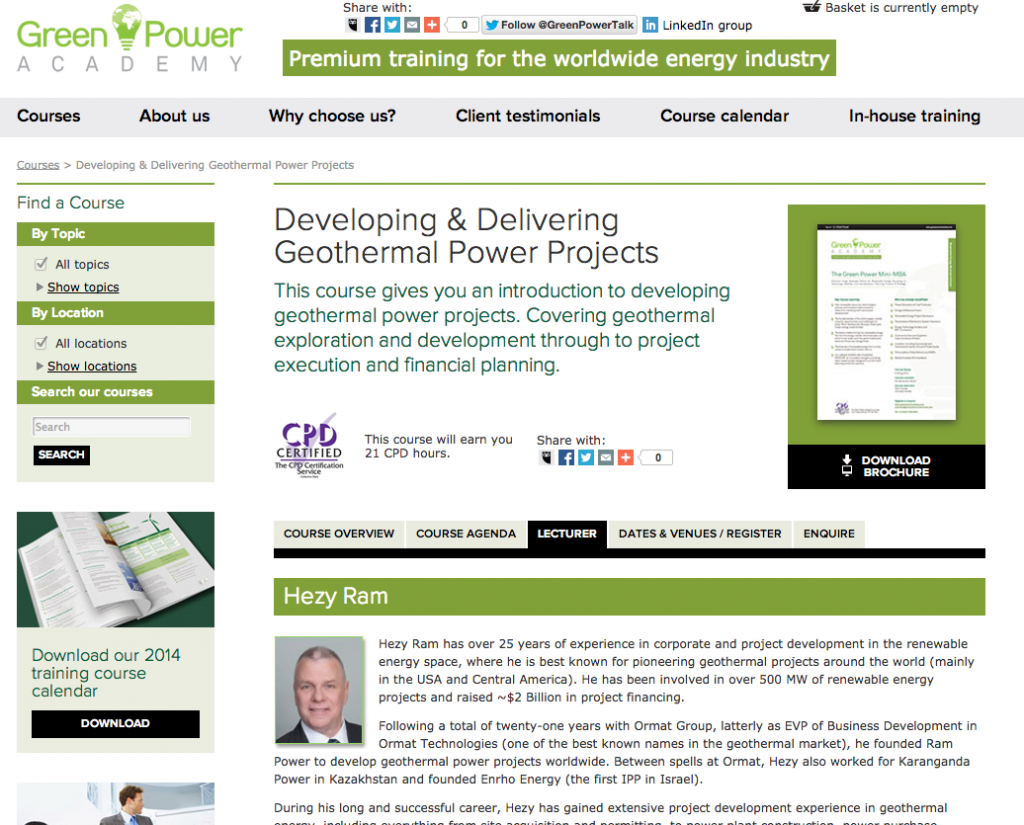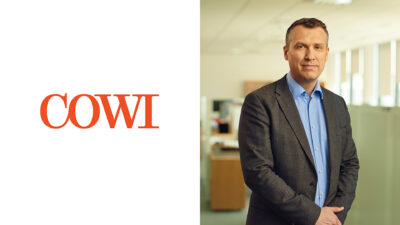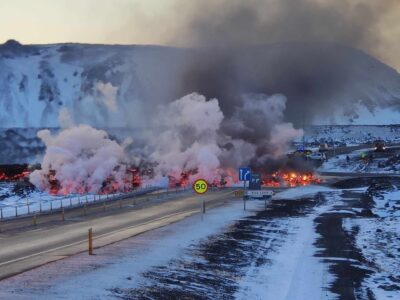Interview With Hezy Ram from Green Power Academy
Hezy Ram is interviewed in Green Power Academy where he is a lecturer for a course in Geothermal development and delivery.
In the Green Power Academy website, Mr Hezy Ram imparts a course in Geothermal development and delivery. Alongside the course, there is the following insightful interview:
Hezy Ram has over 25 years of experience in corporate and project development in the renewable energy space, where he is best known for pioneering geothermal projects around the world (mainly in the USA and Central America). He has been involved in over 500 MW of renewable energy projects and raised ~$2 Billion in project financing.
Following a total of twenty-one years with Ormat Group, latterly as EVP of Business Development in Ormat Technologies (one of the best known names in the geothermal market), he founded Ram Power to develop geothermal power projects worldwide. Between spells at Ormat, Hezy also worked for Karanganda Power in Kazakhstan and founded Enrho Energy (the first IPP in Israel).
During his long and successful career, Hezy has gained extensive project development experience in geothermal energy, including everything from site acquisition and permitting, to power plant construction, power purchase agreements, transmission, project operation and maintenance, financing and tax monetization. He is thus uniquely qualified to deal with both the technical and commercial aspects of the renewable energy business.
Hezy has an MBA from Hebrew University in Israel, along with MS and BSc degrees in Mechanical Engineering from Ben Gurion University. In August, 2011, The Geothermal Energy Association awarded Mr. Ram Special Recognition for outstanding achievement in the geothermal industry.
What do you think are the main challenges facing geothermal power project developers at the moment?
These are clearly interesting times regarding the advance of the geothermal projects worldwide. Generally speaking, we watch different issues and challenge in the developed and developing world. In the developed countries such as the US and NZ, the development of new geothermal projects had slowed dramatically. While such countries have a well-established legal infrastructure in place, geothermal power is either non-competitive price wise (US) or the country does not need more power (NZ and Iceland). So we need better pricing and increased demand for geothermal power in the developed world in order to reinvigorate the development of new projects. Add to it the fact that the better sites have already been explored and it is clear that the challenges of developing more geothermal projects in this part of the world are going to stay with us for a while. The success of bringing geothermal power on line in the developing countries is almost always tied up to the government policies. When these policies are clear, consistent and transparent, you see the private sector getting involved in no time. Case in point is Turkey which went from 15 MW to 266 MW (this year) in a few years. On the other hand, countries like Indonesia which not only commands the largest potential of geothermal resources worldwide, but is also in a dire need for cheap power, has stalled. In between you find countries like Kenya which is moving in the right direction, and Costa Rica which stuck to the concept that only the Government can explore and construct geothermal projects.
What do you believe are the main factors that people tend to overlook or underestimate when financing geothermal power projects?
Financing geothermal projects are similar but at the same time dissimilar to other RE technologies. While the fuel factor associated with say solar, wind or even hydro is quite visible and predictable to a large extent, geothermal fuel (steam or hot water) poses a different set of challenges. The fuel issue is the most important item as to the long term economic viability of any geothermal projects. The resource development stage is traditionally characterized by potential cost overruns and drilling related issues. The long term challenge is the proper maintenance of the geothermal field and how to optimize the combined operation of field and plant on a sustainable basis. There a few ways to mitigate some of these issues and they all involve the selection of the right team to perform the job. A qualified and experienced team will spend the time on proper planning, budget the work properly and will not be swayed to compromise in order to make the project look (on paper) better than what is the reality.
What would you say are the main trends within the geothermal power industry?
I guess that I can spot a few trends at this stage, some technical and the others more policy oriented or commercial in nature. On the technical side, we see a multiplication of suppliers for the medium/low enthalpy space. While the 3 Japanese suppliers (Fuji, Toshiba and MHI) and Alstom control the high enthalpy space, what is known as the binary space attracted many suppliers. Ormat used to be synonymous with binary power plants, but developers today can go the European suppliers like Exergy or Japanese suppliers like MHI and Fuji for the same technology. Another interesting concept which is making inroads recently will be the ‘well head generator” which allows one or two wells projects. This concept is more in line with the idea of DG and may catch steam in years to come. The innovative in this space is GEG which demonstrated that Steam Condensing Turbines can be quite efficient at lower rating than we used to consider.
On the policy side, I believe that we see a real desire by many countries that did not develop geothermal before (or were slow in doing it) to move forward more. This phenomena is really unique to developing countries (with the exception of Chile which so far acted like it was a developing country in that context) in Asia, Africa and Central America. I also can spot quite a few attempts by both institutions as well as the private sector to deal with the “Exploration Risk” which is biggest obstacle in developing “green fields”.
What’s your background in geothermal project development?
I have been involved in Geothermal for about 25 years, the best part of which I spent with Ormat Technologies. While there I focused on North America which provided the growth for Ormat at that time. Later in life I founded RPI which developed a large project in Nicaragua. This experience provided me with the exposure to the developing countries culture and way of doing business. As a I have both technical and financial background I tend to consider myself as a well-rounded executive in this space. Currently developing a 140 MW project in Kenya and spending a lot of time in training course sponsored by the USAID or private entities. I find geothermal while extremely challenging, fascinating and I know that this is the RE of choice for any power company any place.
On previous courses, what would you say are the key things that people have found eye-opening and most likely to change how they think about geothermal projects?
The audience of my trainees is mixed and roughly speaking is split between technical and non-technical persons. While generalizing is always a bit inaccurate I would state the following: the technical people are fascinated by the concept of project finance never have enough of it. The non-technical crowd is quite impressed with the amount of science and engineering going in developing the projects from ground up. I would expect that people who graduate from our courses will have a more comprehensive understanding of what it entails to develop and finance a geothermal project.
Source: Green Power Academy Website


















